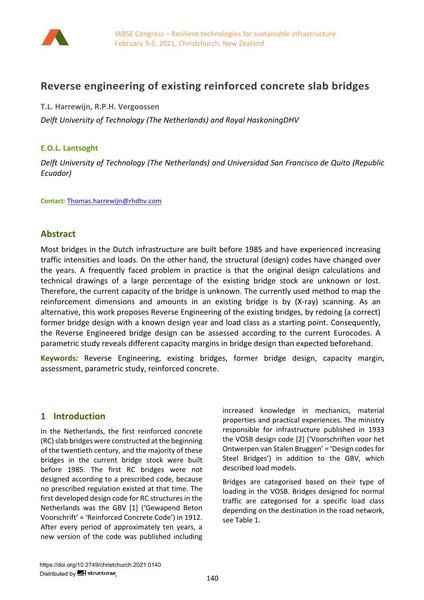Reverse engineering of existing reinforced concrete slab bridges

|
|
|||||||||||
Détails bibliographiques
| Auteur(s): |
T. L. Harrewijn
(Delft University of Technology (The Netherlands) and Royal HaskoningDHV)
R. P. H. Vergoossen (Delft University of Technology (The Netherlands) and Royal HaskoningDHV) E. O. L. Lantsoght (Delft University of Technology (The Netherlands) and Universidad San Francisco de Quito (Republic Ecuador)) |
||||
|---|---|---|---|---|---|
| Médium: | papier de conférence | ||||
| Langue(s): | anglais | ||||
| Conférence: | IABSE Congress: Resilient technologies for sustainable infrastructure, Christchurch, New Zealand, 3-5 February 2021 | ||||
| Publié dans: | IABSE Congress Christchurch 2020 | ||||
|
|||||
| Page(s): | 140-147 | ||||
| Nombre total de pages (du PDF): | 8 | ||||
| DOI: | 10.2749/christchurch.2021.0140 | ||||
| Abstrait: |
Most bridges in the Dutch infrastructure are built before 1985 and have experienced increasing traffic intensities and loads. On the other hand, the structural (design) codes have changed over the years. A frequently faced problem in practice is that the original design calculations and technical drawings of a large percentage of the existing bridge stock are unknown or lost. Therefore, the current capacity of the bridge is unknown. The currently used method to map the reinforcement dimensions and amounts in an existing bridge is by (X-ray) scanning. As an alternative, this work proposes Reverse Engineering of the existing bridges, by redoing (a correct) former bridge design with a known design year and load class as a starting point. Consequently, the Reverse Engineered bridge design can be assessed according to the current Eurocodes. A parametric study reveals different capacity margins in bridge design than expected beforehand. |
||||
